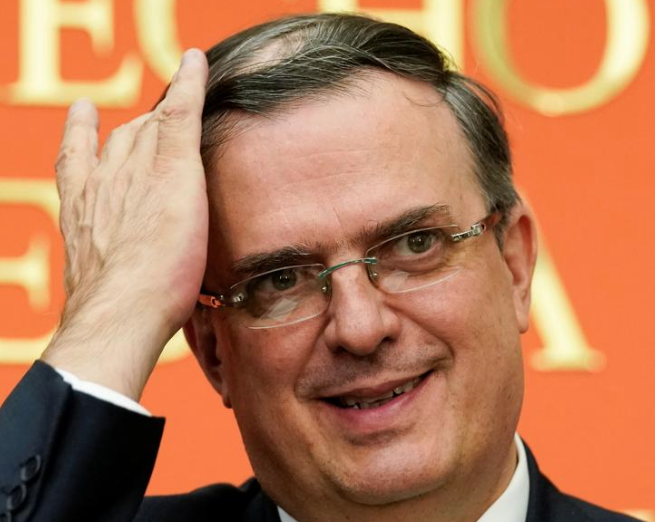
Roberta Rampton, Richard Cowan
WASHINGTON (Reuters) – Mexican officials met with their U.S. counterparts for talks in Washington on Wednesday aimed at averting the imposition of U.S. tariffs on Mexican goods next week, but there were no immediate signs of a rapprochement and both sides said talks would resume on Thursday.
Frustrated by the lack of progress on a signature issue from his 2016 election campaign, U.S. President Donald Trump unexpectedly told Mexico last week to take a harder line on curbing illegal immigration or face 5% tariffs on all its exports to the United States starting on Monday, rising to as much as 25% later in the year.
U.S. Vice President Mike Pence chaired the meeting on Wednesday afternoon with Secretary of State Mike Pompeo and Mexican Foreign Minister Marcelo Ebrard to make the case that Mexico needed to do more to stop a surge in Central American migrants crossing the border.
But with Trump in Europe for D-Day commemoration ceremonies until Friday, a quick resolution had never been anticipated.
“Immigration discussions at the White House with representatives of Mexico have ended for the day. Progress is being made, but not nearly enough!” Trump said in a tweet on Wednesday evening. He said talks would resume on Thursday.
Pence had expected to hear “tangible measures” that the Mexican government was prepared to take “immediately,” a White House official said ahead of the meeting. White House officials were not immediately available for comment afterwards.
If the tariffs go ahead, the United States would be in a serious trade dispute with both China and Mexico – two of its three top trading partners. That is a situation that U.S. business groups are keen to avoid.
Mexico also wants to stop a trade war that analysts believe might tip its economy into a recession and Mexican President Andres Manuel Lopez Obrador has said he is optimistic that an agreement will be reached.
But his administration is preparing for a no-deal outcome, too.
An official list of U.S. products that could be subject to retaliatory tariffs if the duties take effect is principally tailored toward products from agricultural and industrial states regarded as Trump’s electoral base, a Mexican official said.
With the clock ticking toward U.S. elections in 2020, Trump is facing resistance within his own Republican Party to strike a deal and avoid the tariffs. Many lawmakers are concerned about the potential impact on cross-border trade and increased costs for U.S. businesses and consumers on imported Mexican goods from cars and auto parts to beer and fruit.
John Thune of South Dakota, the No. 2 Senate Republican, told reporters: “We have conveyed our concerns to the administration. There are a good number of Republican senators who have expressed both publicly and privately to the White House their concerns about this.”
White House trade adviser Peter Navarro told CNN the tariffs might not be needed because the threat alone was enough to “have the Mexicans’ attention.”
During a visit to Ireland on Wednesday, Trump said Mexico could still stop the tariffs being imposed. “Mexico can stop it. They have to stop it, otherwise we just won’t be able to do business,” he said. “I think they want to make a deal, and they sent their top people to try and do it.”
BORDER APPREHENSIONS RISE
U.S. border officers apprehended more than 132,000 people crossing from Mexico in May, the Trump administration said on Wednesday, the highest monthly total in more than a decade and reaching what officials said were “crisis” levels.
The conservative Trump administration wants Mexico to stop the migrant numbers rising and toughen the southern border with Guatemala – the main entry point for Central Americans into Mexico – if it is to avoid the tariffs.
The leftist administration of Lopez Obrador is proposing redirecting U.S. security funding towards boosting economic development in poverty-stricken southern Mexico and Guatemala to attack the root causes of migration, two Mexican government sources said.Slideshow (4 Images)
U.S. border authorities have said they are overwhelmed not so much by the number of migrants but by a shift in the type of person turning up at the border.
Increasing numbers of Central American families and unaccompanied minors seeking asylum after fleeing criminal violence in their home countries have been turning themselves in to U.S. border agents, who have long been geared up to catch mainly single, adult Mexicans trying to cross clandestinely.
“Our nation is experiencing an unprecedented border security and humanitarian crisis on the southwest border, both at and between our ports of entry,” Randy Howe, the executive director for operations, Office of Field Operations at U.S. Customs and Border Protection (CBP), told reporters on a call.
Howe said that on Tuesday alone, CBP apprehended more than 4,100 people and had 19,293 people in custody. “We are bursting at the seams. It is unsustainable,” Howe said.